Similar presentations:
Endpoint Security and Analysis
1. Endpoint Security and Analysis
2.
1 Endpoint Protection• Use a malware analysis website to generate a malware analysis report.
Explain methods of mitigating malware.
Explain host-based IPS/IDS log entries.
Use virustotal.com to generate a malware analysis report.
2 Endpoint Vulnerability Assessment
• Classify endpoint vulnerability assessment information.
Explain the value of network and server profiling.
Classify CVSS reports.
Explain compliance frameworks and reporting.
Explain how secure device management techniques are used to protect data and assets.
Explain how information security management systems are used to protect assets.
© 2016 Cisco and/or its affiliates. All rights reserved. Cisco Confidential
2
3. Endpoint Protection
© 2016 Cisco and/or its affiliates. All rights reserved. Cisco Confidential3
4. Antimalware Protection Endpoint Threats
Endpoint ThreatsIncreased number of devices due to mobility and IoT
Over 75% of organizations experienced adware infections from 2015-2016
From 2016 to early 2017, global spam volume increased dramatically
Malware that targets the Android mobile operating system was in the top ten most common type
found in 2016
• Several common types of malware can significantly change features in less than 24 hours in
order to evade detection.
© 2016 Cisco and/or its affiliates. All rights reserved. Cisco Confidential
4
5. Antimalware Protection Endpoint Security
Two internal LAN elements to secure:• Endpoints - Hosts commonly consist of
laptops, desktops, printers, servers, and IP
phones.
• Network infrastructure - LAN infrastructure
devices interconnect endpoints and
typically include switches, wireless devices,
and IP telephony devices.
© 2016 Cisco and/or its affiliates. All rights reserved. Cisco Confidential
5
6. Antimalware Protection Host-Based Malware Protection
Antimalware/antivirus software.• Signature-based – Recognizes various
characteristics of known malware files.
• Heuristics-based – Recognizes general features
shared by various types of malware.
• Behavior-based – Employs analysis of
suspicious behavior.
Host-based Firewall - restricts incoming and
outgoing connections.
Host-based Security Suites - include antivirus,
anti-phishing, safe browsing, Host-based
intrusion prevention system, firewall capabilities
and robust logging functionality.
© 2016 Cisco and/or its affiliates. All rights reserved. Cisco Confidential
6
7. Antimalware Protection Network-Based Malware Protection
Network-based malware protection• Advanced Malware
Protection (AMP)
• Email Security Appliance (ESA)
• Web Security Appliance (WSA)
• Network Admission Control (NAC)
© 2016 Cisco and/or its affiliates. All rights reserved. Cisco Confidential
7
8. Antimalware Protection Cisco Advanced Malware Protection (AMP)
Cisco Advanced Malware Protection(AMP) addresses all phases of a malware
attack:
• Before an attack - AMP uses global threat
intelligence from Cisco’s Talos Security
Intelligence and Research Group, and
Threat Grid’s threat intelligence feeds.
• During an attack - AMP uses that
intelligence coupled with known file
signatures and Cisco Threat Grid’s
dynamic malware analysis technology.
• After an attack - The solution goes
beyond point-in-time detection capabilities
and continuously monitors and analyzes
all file activity and traffic.
© 2016 Cisco and/or its affiliates. All rights reserved. Cisco Confidential
8
9. Host-Based Intrusion Protection Host-Based Firewalls
Host-based personal firewalls are standalonesoftware programs that control traffic entering or
leaving a computer.
Host-based firewalls include;
• Windows Firewall - uses a profile-based
approach to configuring firewall functionality.
• Iptables - allows Linux system administrators to
configure network access rules.
• Nftables - successor to iptables, nftables is a
Linux firewall application that uses a simple
virtual machine in the Linux kernel.
• TCP Wrapper for Linux-based devices - rulebased access control and logging system.
© 2016 Cisco and/or its affiliates. All rights reserved. Cisco Confidential
9
10. Host-Based Intrusion Protection Host-Based Intrusion Detection
Host-Based Intrusion Detection System (HIDS)protects hosts against malware and can perform
the following:
• monitoring and reporting
• log analysis
• event correlation
• integrity checking
• policy enforcement
• rootkit detection
HIDS software must run directly on the host, so
it is considered an agent-based system.
© 2016 Cisco and/or its affiliates. All rights reserved. Cisco Confidential
10
11. Host-Based Intrusion Protection HIDS Operation
A HIDS can prevent intrusion because it usessignatures to detect known malware and
prevent it from infecting a system.
An additional set of strategies are used to
detect malware that evades signature
detection:
• Anomaly-based - host behavior is compared to
a learned baseline model.
• Policy-based – normal behavior is described by
rules or by the violation of predefined rules.
© 2016 Cisco and/or its affiliates. All rights reserved. Cisco Confidential
11
12. Host-Based Intrusion Protection HIDS Products
Most HIDS utilize software on the host andsome sort of centralized security management
functionality that allows integration with
network security monitoring services and
threat intelligence.
• Examples: Cisco AMP, AlienVault USM,
Tripwire, and Open Source HIDS SECurity
(OSSEC).
• OSSEC uses a central manager server and
agents that are installed on individual hosts.
© 2016 Cisco and/or its affiliates. All rights reserved. Cisco Confidential
12
13. Application Security Attack Surface
An attack surface is the total sum of thevulnerabilities.
• Include open ports, applications, wireless
connections, and users.
Expanding due to cloud-based systems,
mobile devices, BYOD and the IoT.
The SANS Institute describes three
components of the attack surface:
• Network Attack Surface
• Software Attack Surface
• Human Attack Surface
© 2016 Cisco and/or its affiliates. All rights reserved. Cisco Confidential
13
14. Application Security Application Blacklisting and Whitelisting
Application blacklist – which apps are notpermitted.
Application whitelist – which apps are allowed
to run.
Whitelists are created in accordance with a
security baseline that has been established by
an organization.
Websites can also be whitelisted and
blacklisted.
• Cisco’s FireSIGHT security management
system is an example of a device that can
access the Cisco Talos security intelligence
service to obtain blacklists.
© 2016 Cisco and/or its affiliates. All rights reserved. Cisco Confidential
14
15. Application Security System-Based Sandboxing
Sandboxing is a technique that allowssuspicious files to be analyzed and run in a
safe environment.
Cuckoo Sandbox for example, is a free
malware analysis system sandbox. It can
be run locally and have malware samples
submitted to it for analysis.
© 2016 Cisco and/or its affiliates. All rights reserved. Cisco Confidential
15
16. Endpoint Vulnerability Assessment
© 2016 Cisco and/or its affiliates. All rights reserved. Cisco Confidential16
17. Network and Server Profiling Network Profiling
Network profiling – create a baseline tocompare against when an attack occurs.
Elements of a network baseline should include:
• Session duration
• Total throughput
• Critical asset address space
• Typical traffic type
© 2016 Cisco and/or its affiliates. All rights reserved. Cisco Confidential
17
18. Network and Server Profiling Server Profiling
Server profiling – includes listening ports, logged in users/service accounts, running processes,running tasks, and applications
© 2016 Cisco and/or its affiliates. All rights reserved. Cisco Confidential
18
19. Network and Server Profiling Network Anomaly Detection
Network behavior is described by a largeamount of diverse data such as the features of
packet flow, features of the packets
themselves, and telemetry from multiple
sources.
Big Data analytics techniques can be used to
analyze this data and detect variations from the
baseline.
Anomaly detection can recognize network
congestion caused by worm traffic and also
identify infected hosts on the network.
© 2016 Cisco and/or its affiliates. All rights reserved. Cisco Confidential
19
20. Network and Server Profiling Network Vulnerability Testing
Network vulnerability testing can include risk analysis, vulnerability assessment, and penetrationtesting.
© 2016 Cisco and/or its affiliates. All rights reserved. Cisco Confidential
20
21. Common Vulnerability Scoring System (CVSS) CVSS Overview
Common Vulnerability Scoring System(CVSS) is a risk assessment designed
to convey the common attributes and
severity of vulnerabilities in computer
hardware and software systems.
Standardized vulnerability scores
Open framework with metrics
Helps prioritize risk in a meaningful
way
© 2016 Cisco and/or its affiliates. All rights reserved. Cisco Confidential
21
22. Common Vulnerability Scoring System (CVSS) CVSS Metric Groups
CVSS uses three groups of metrics toassess vulnerability:
• Base Metric Group - represents the
characteristics of a vulnerability that are
constant over time and across contexts.
• Temporal Metric Group - measures the
characteristics of a vulnerability that may
change over time, but not across user
environments.
• Environmental Metric Group measures the aspects of a vulnerability
that are rooted in a specific organization’s
environment.
© 2016 Cisco and/or its affiliates. All rights reserved. Cisco Confidential
22
23. Common Vulnerability Scoring System (CVSS) CVSS Base Metric Group
Base Metric Group Exploitability metrics include thefollowing criteria:
• Attack vector
• Attack complexity
• Privileges required
• User interaction
• Scope
Impact metric components include:
• Confidentiality Impact
• Integrity Impact
• Availability Impact
© 2016 Cisco and/or its affiliates. All rights reserved. Cisco Confidential
23
24. Common Vulnerability Scoring System (CVSS) The CVSS Process
CVSS process uses a tool called theCVSS v3.0 Calculator.
The calculator is similar to a
questionnaire in which choices are made
that describe the vulnerability for each
metric group. Then a score is generated.
The Base Metric group is first completed.
Then the Temporal and Environmental
metric values modify the Base Metric
results to provide an overall score.
© 2016 Cisco and/or its affiliates. All rights reserved. Cisco Confidential
24
25. Common Vulnerability Scoring System (CVSS) CVSS Reports
The higher the severity rating, the greater the potential impact of an exploit and the greaterthe urgency in addressing the vulnerability.
A vulnerability that exceeds 3.9 should be addressed.
© 2016 Cisco and/or its affiliates. All rights reserved. Cisco Confidential
25
26. Common Vulnerability Scoring System (CVSS) Other Vulnerability Information Sources
Common Vulnerabilities and Exposures(CVE) - dictionary of common names, in the
form of CVE identifiers, for known cybersecurity
vulnerabilities.
National Vulnerability Database (NVD) -
utilizes CVE identifiers and supplies additional
information such as CVSS threat scores,
technical details, affected entities, and
resources for further investigation.
© 2016 Cisco and/or its affiliates. All rights reserved. Cisco Confidential
26
27. Compliance Frameworks Compliance Regulations
To prevent security breaches, a number of securitycompliance regulations have emerged.
The regulations offer a framework for practices that
enhance information security while also stipulating
incidence response actions and penalties for failure to
comply.
© 2016 Cisco and/or its affiliates. All rights reserved. Cisco Confidential
27
28. Compliance Frameworks Overview of Regulatory Standards
Cybersecurity regulations that impact cybersecurity• FISMA (Federal Information Security Management Act of 2002) – security standards for U.S.
government systems and contractors.
• SOX (Sarbanes-Oxley Act of 2002) – requirements for U.S.
public company boards, management, and public accounting
firms regarding control and disclosure of financial information.
• HIPAA (Health Insurance Portability and Accountability Act) –
protection of patient healthcare information.
• PCI-DSS (Payment Card Industry Data Security Standard) –
proprietary, non-governmental standard created by five major
credit card companies that defines requirements for secure
handling of customer credit card data.
• GLBA (Gramm-Leach-Bliley Act) – requirements for security
of customer information by financial institutions.
© 2016 Cisco and/or its affiliates. All rights reserved. Cisco Confidential
28
29. Secure Device Management Risk Management
Risk management involves the selectionand specification of security controls for an
organization.
• Risk avoidance - Stop performing the
activities that create risk.
• Risk reduction - Take measures to reduce
vulnerability.
• Risk sharing - Shift some of the risk to other
parties.
• Risk retention - Accept the risk and its
consequences.
© 2016 Cisco and/or its affiliates. All rights reserved. Cisco Confidential
29
30. Secure Device Management Vulnerability Management
Vulnerability management is a security practice designed to proactivelyprevent the exploitation of IT vulnerabilities.
The steps in the Vulnerability Management Life Cycle:
• Discover - Inventory all assets across the network and identify host
details. Develop a network baseline. Identify security vulnerabilities on a
regular automated schedule.
• Prioritize Assets - Categorize assets into groups or business units, and
assign a business value to asset groups based on their criticality to
business operations.
• Assess - Determine a baseline risk profile to eliminate.
• Report - Measure the level of business risk associated with your assets.
Document a security plan, monitor suspicious activity, and describe known
vulnerabilities.
• Remediate - Prioritize according to business risk and address
vulnerabilities in order of risk.
• Verify - Verify that threats have been eliminated through follow-up audits.
© 2016 Cisco and/or its affiliates. All rights reserved. Cisco Confidential
30
31. Secure Device Management Asset Management
Asset management – track location and configuration of devices and software© 2016 Cisco and/or its affiliates. All rights reserved. Cisco Confidential
31
32. Secure Device Management Mobile Device Management
Mobile device management (MDM) – configure, monitor, and update mobile clients© 2016 Cisco and/or its affiliates. All rights reserved. Cisco Confidential
32
33. Secure Device Management Configuration Management
Configuration Management – NIST Definition - comprises a collection of activities focusedon establishing and maintaining the integrity of products and systems, through control of the
processes for initializing, changing, and monitoring the configurations of those products and
systems.
Configuration management tools examples – Puppet, Ansible, Saltsack, Chef.
© 2016 Cisco and/or its affiliates. All rights reserved. Cisco Confidential
33
34. Secure Device Management Enterprise Patch Management
Patch management involves all aspects of software patching, including identifying requiredpatches, acquiring, distributing, installing, and verifying that the patch is installed on all
required systems.
© 2016 Cisco and/or its affiliates. All rights reserved. Cisco Confidential
34
35. Secure Device Management Patch Management Techniques
Three patch management techniques:• Agent-based – software on each host.
• Agentless scanning – patch management servers scan for devices that need patching.
• Passive network monitoring – monitor network traffic to identify which devices need patching.
Agent-based
Passive network
monitoring
Agentless Scanning
© 2016 Cisco and/or its affiliates. All rights reserved. Cisco Confidential
35
36. Information Security Management Systems Security Management Systems
Management framework to identify, analyze, and address information security risksISMSs provide conceptual models that guide organizations in planning, implementing,
governing, and evaluating information security programs.
© 2016 Cisco and/or its affiliates. All rights reserved. Cisco Confidential
36
37. Information Security Management Systems ISO-27001
ISO/IEC 27000 family of standards – internationally accepted standards that facilitate businessconducted between countries
The ISO 27001 Certification is a global, industry-wide specification for an ISMS.
© 2016 Cisco and/or its affiliates. All rights reserved. Cisco Confidential
37
38. Information Security Management Systems NIST Cybersecurity Framework
NIST Cybersecurity Framework - a set of standards designed to integrate existing standards,guidelines, and practices to help better manage and reduce cybersecurity risk.
© 2016 Cisco and/or its affiliates. All rights reserved. Cisco Confidential
38
39. Summary
© 2016 Cisco and/or its affiliates. All rights reserved. Cisco Confidential39
40. Summary
Investigate endpoint vulnerabilities and attacks using antimalware, host-based firewall, and host-basedintrusion detection systems (HIDS).
Attack surface is all of the vulnerabilities accessible to an attacker and can include open ports,
applications, wireless connections, and users.
Three components of the attack surface: network, software, and human.
Baselining is performed by network profiling and server profiling.
A network profile could contain session duration, total throughput, port(s) used, and critical asset
address space.
A server profile commonly contains listening ports, logged in users/service accounts, running processes,
running tasks, and applications.
Network vulnerability testing is performed using risk analysis, vulnerability assessment, and penetration
testing.
CVSS is a vendor-neutral risk assessment that contains three main metric groups (base, temporal, and
environmental). Each group has specific metrics that can be measured.
© 2016 Cisco and/or its affiliates. All rights reserved.
Cisco Confidential
40
41. Summary (Cont.)
Compliance regulations include FISMA, SOX, HIPAA, PCI-DSS, and GLBA.Risk management is used to identify assets, vulnerabilities and threats.
4 methods of risk reduction include risk avoidance, risk reduction, risk sharing, and risk
retention
Vulnerability management proactively prevents the exploitation of IT vulnerabilities. The 6
steps of the vulnerability management lifecycle include discover, prioritize assets, assess,
report, remediate, and verify.
Other device managements that must be considered include asset management, mobile
device management, configuration management, and patch management.
An ISMS consists of a management framework used to identify, analyze, and address
information security risks. Examples include the ISO/IEC 27000 family of standards and
the NIST Cybersecurity Framework Core and Functions.
© 2016 Cisco and/or its affiliates. All rights reserved. Cisco Confidential
41
42. New Terms and Commands
Antivirus/Antimalwareendpoint
Federal Information Security Management Act of 2002 (FISMA)
Gramm-Leach-Bliley Act (GLBA)
Health Insurance Portability and Accountability Act (HIPAA)
Host-based firewall
host-based intrusion detection system (HIDS)
Information Security Management System (ISMS)
Payment Card Industry Data Security Standard (PCI-DSS)
profiling
Sandboxing
Sarbanes-Oxley Act of 2002 (SOX)
© 2016 Cisco and/or its affiliates. All rights reserved. Cisco Confidential
42


















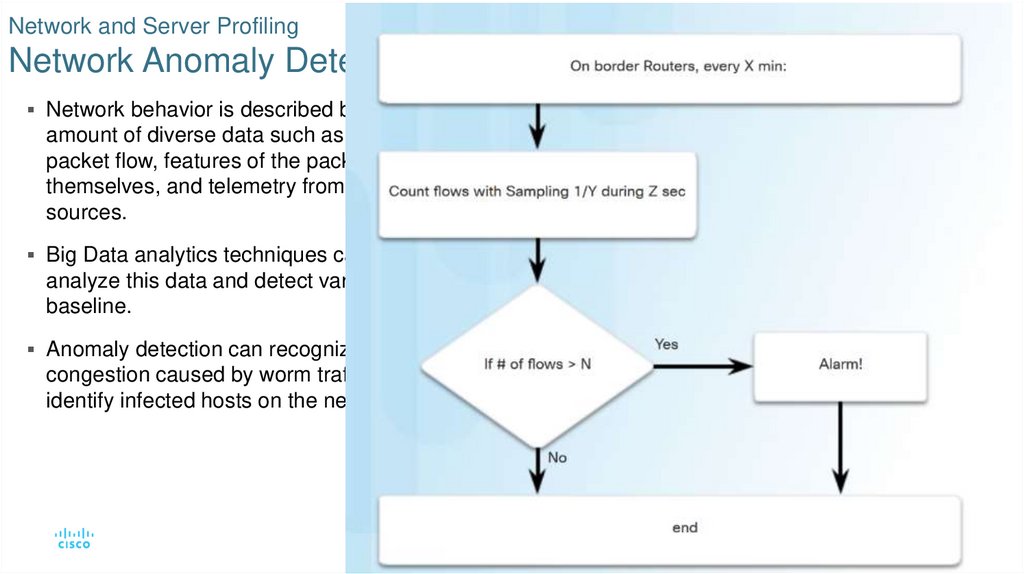

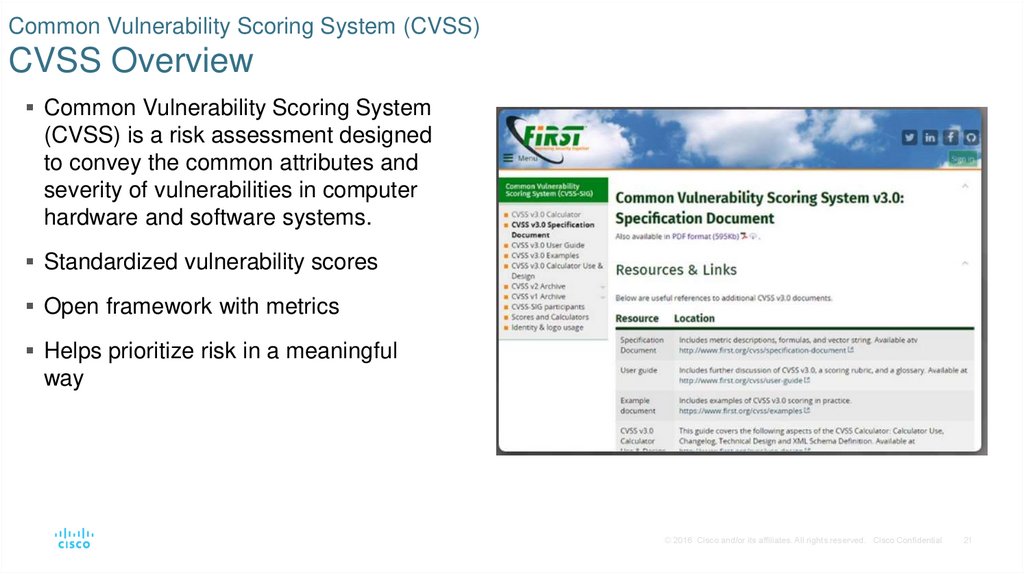
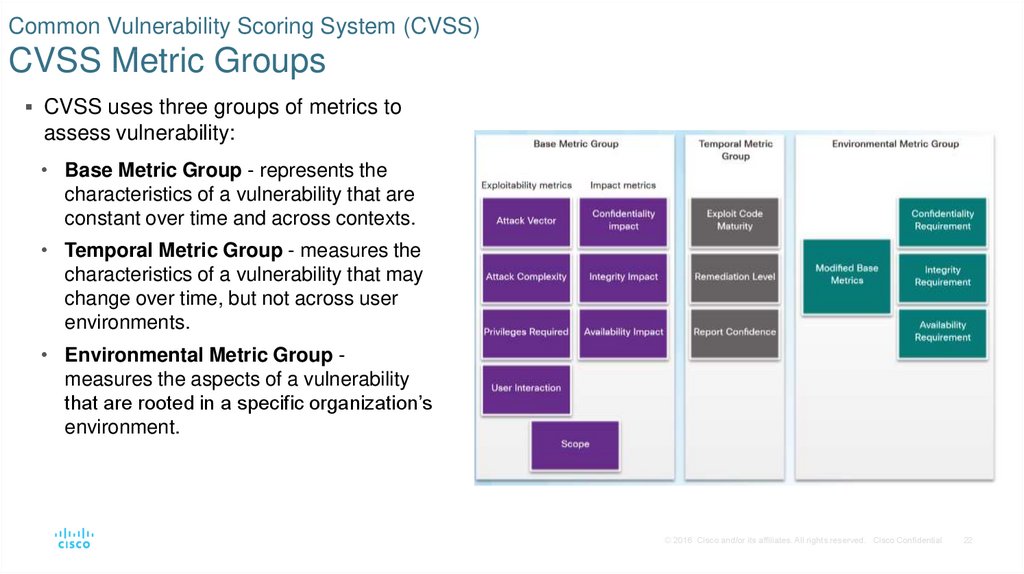

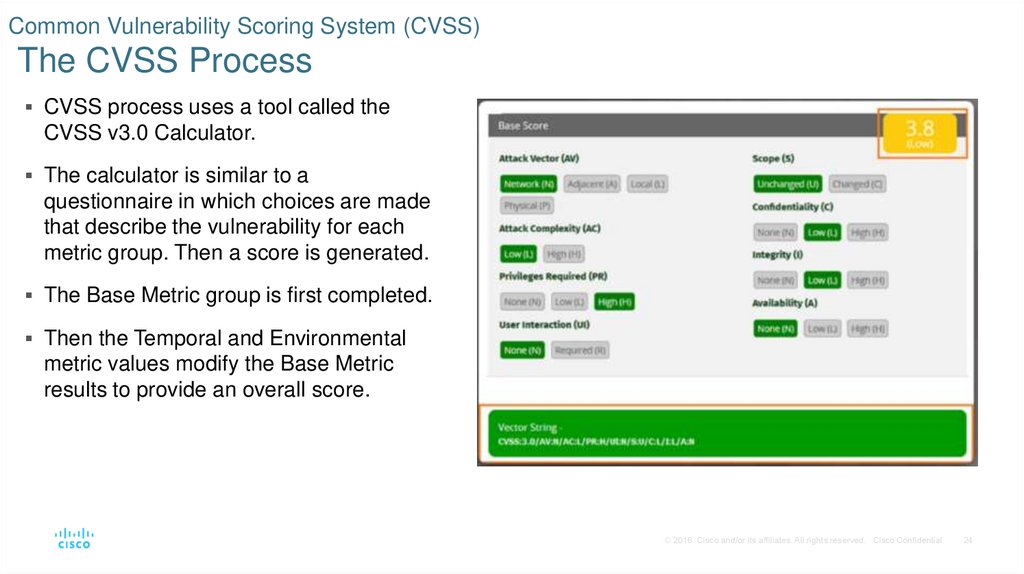
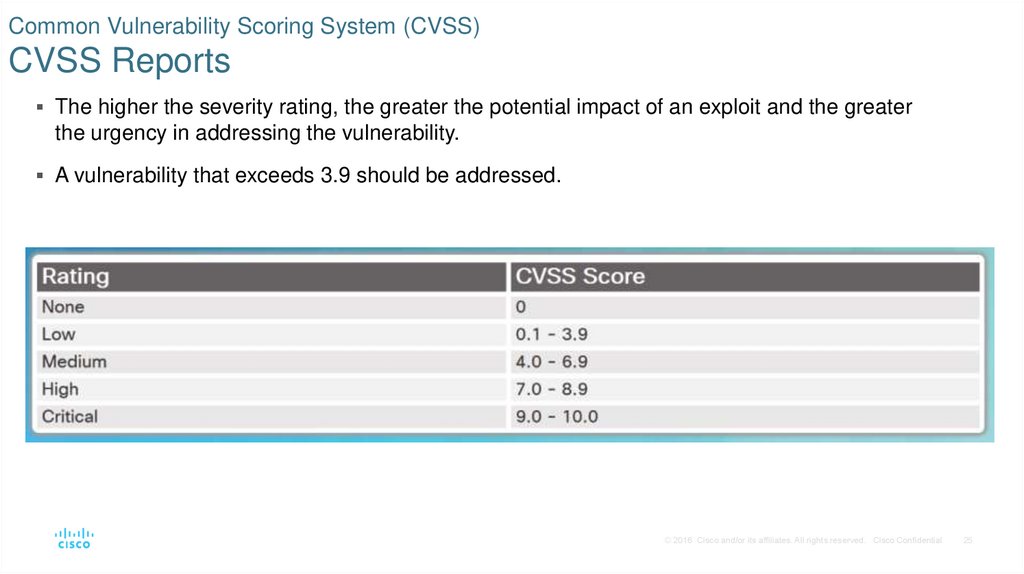
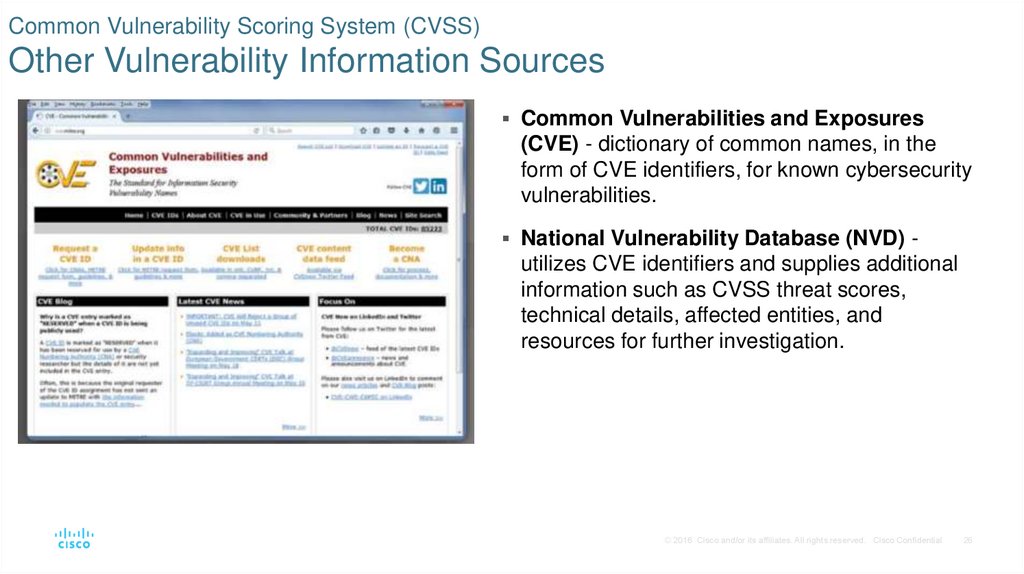
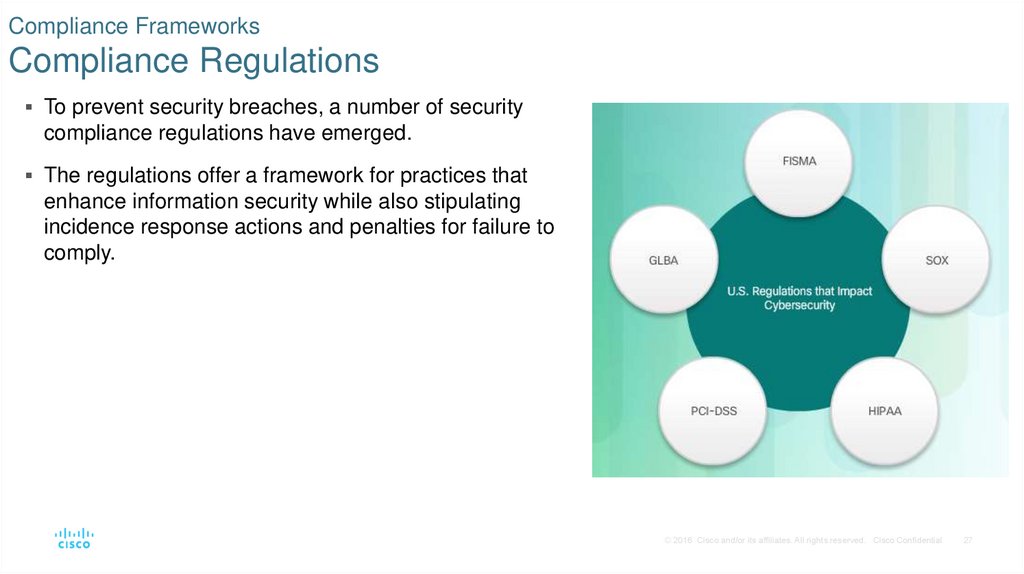
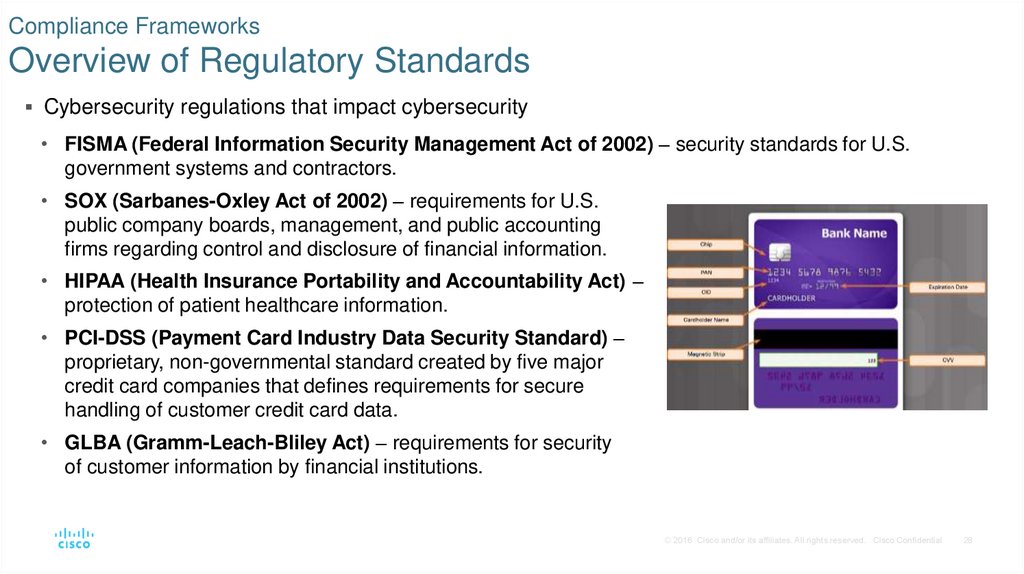
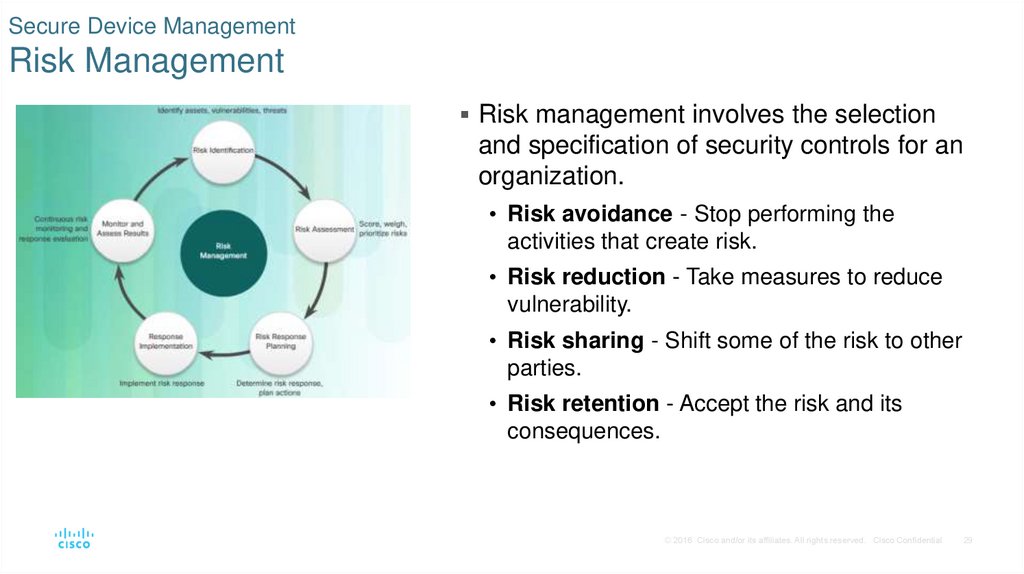
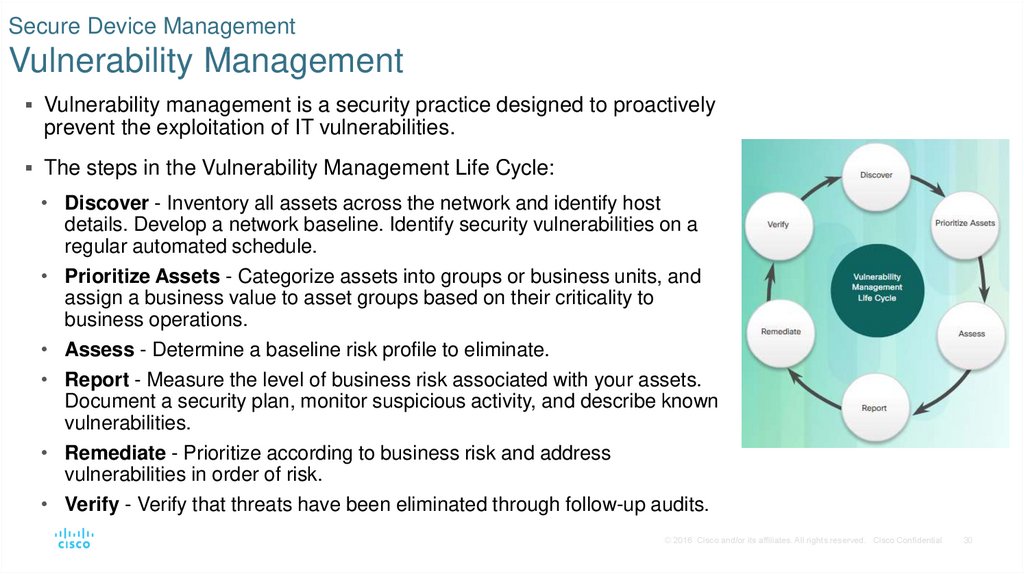
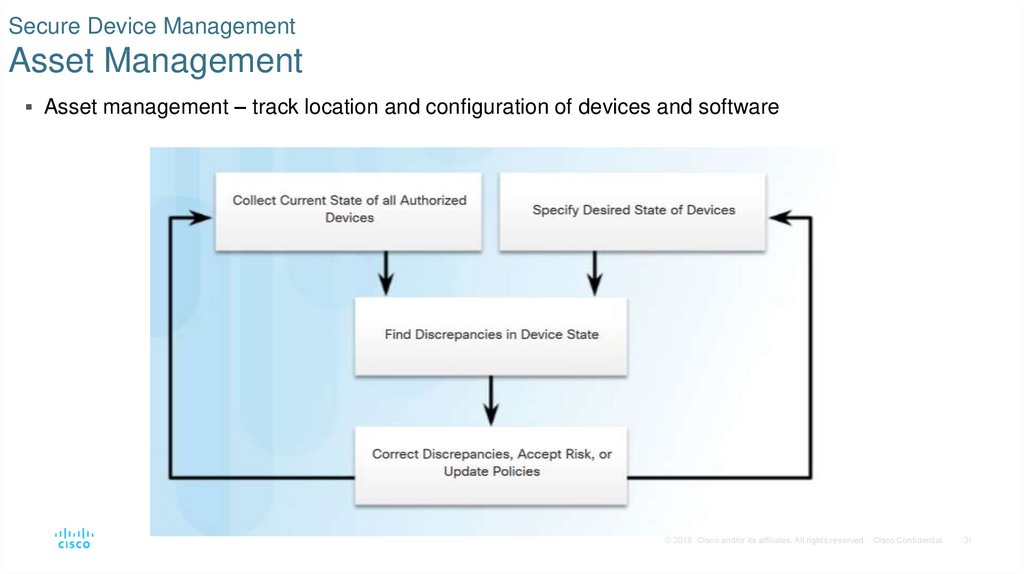
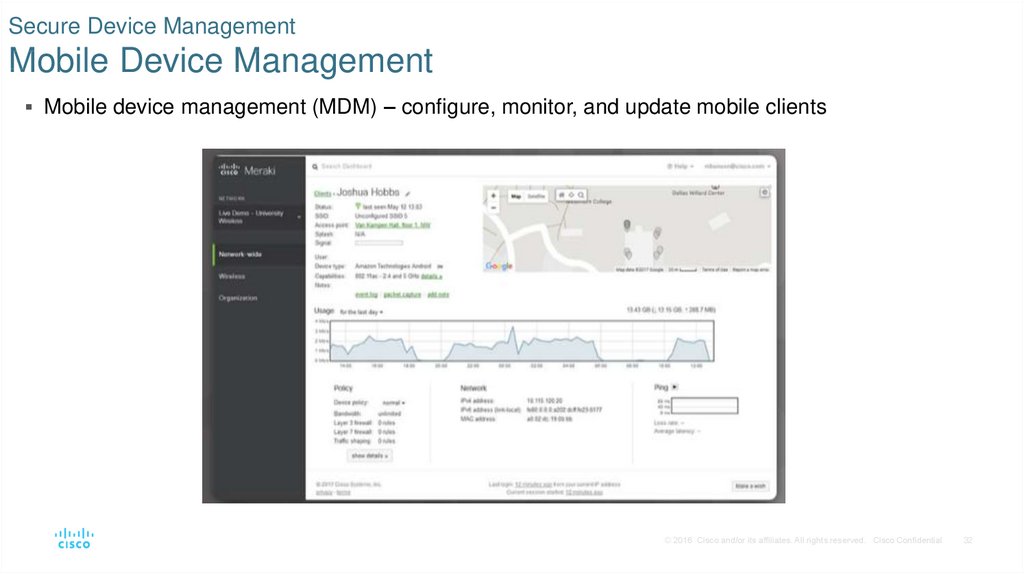
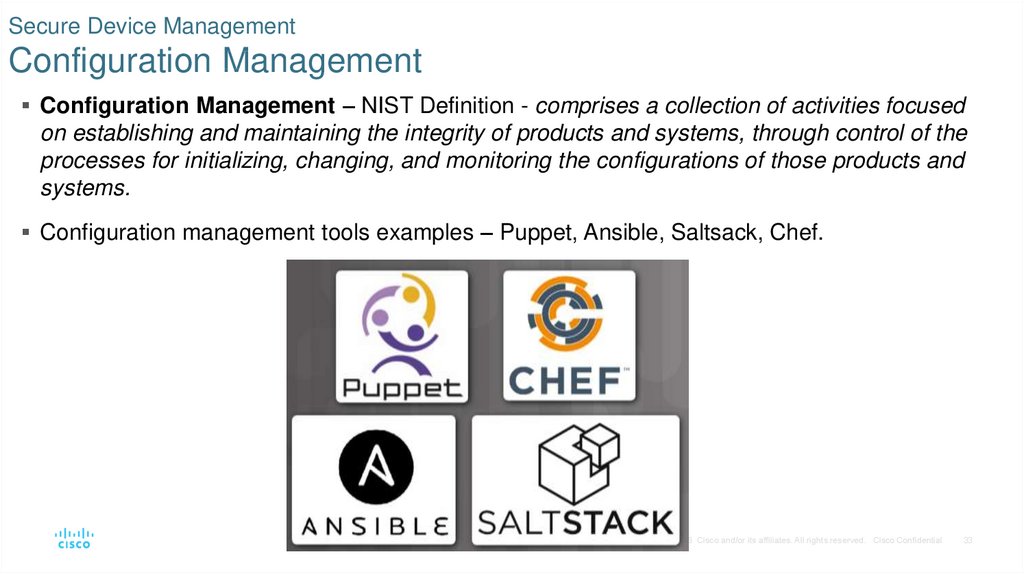
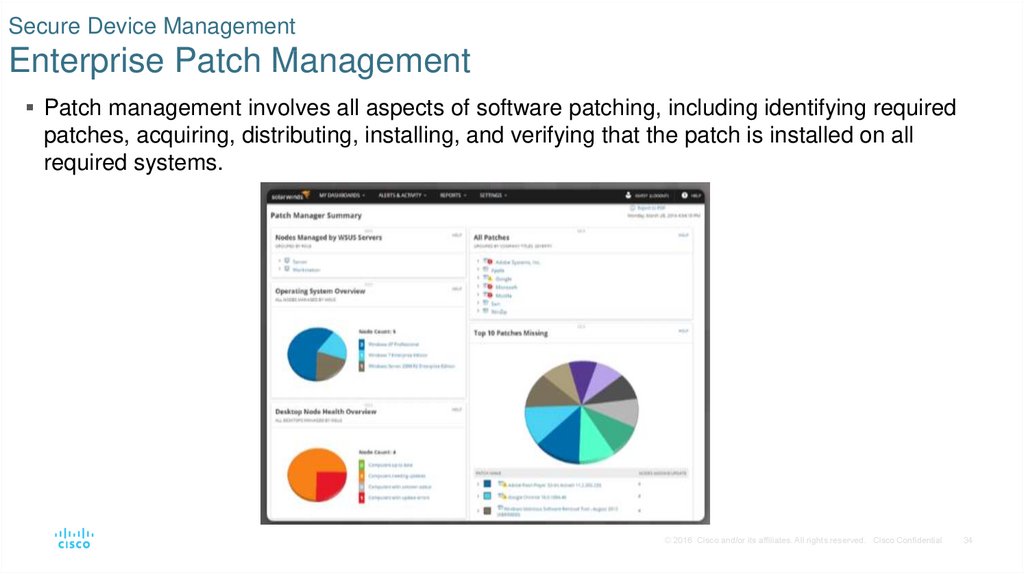
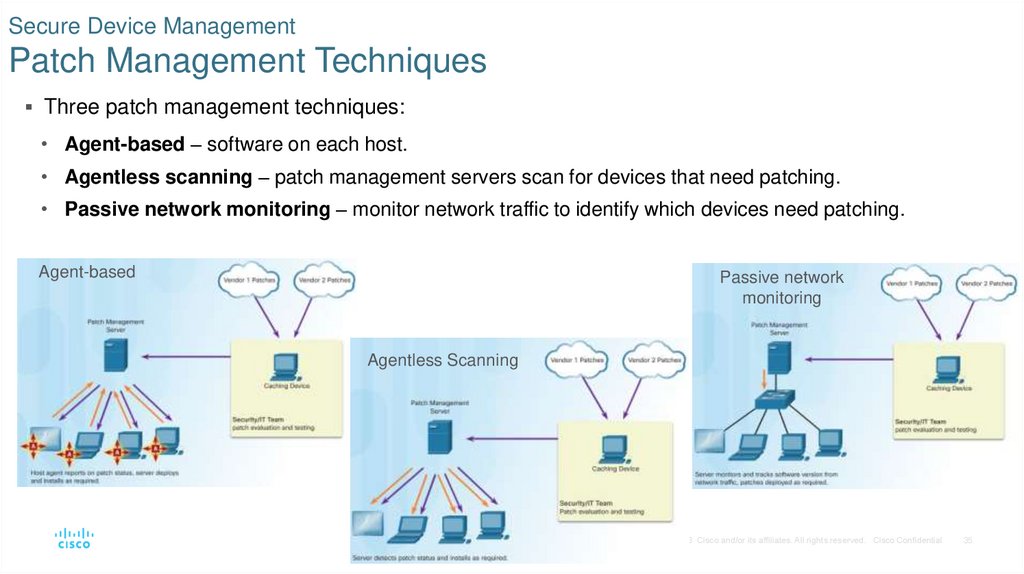
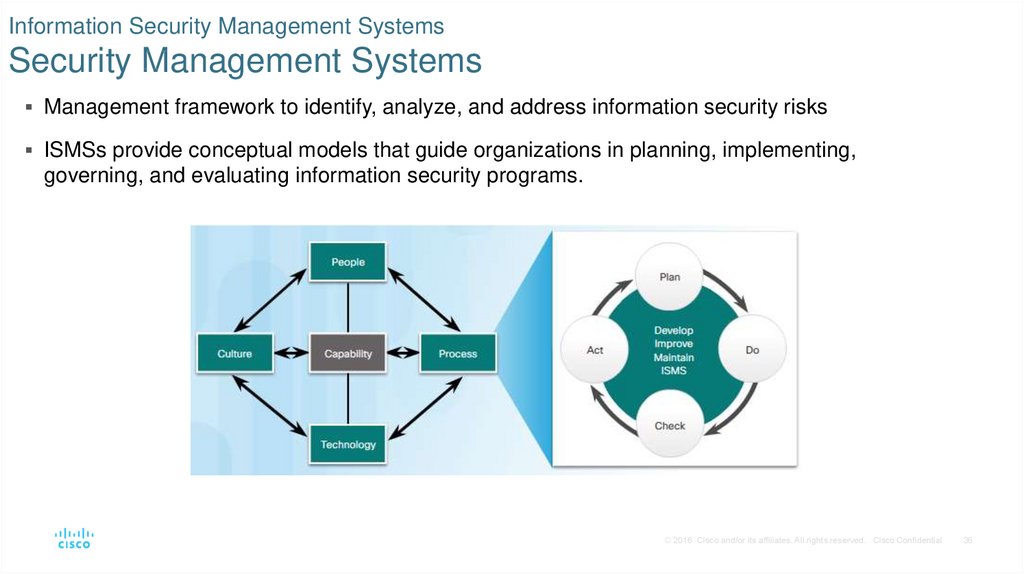
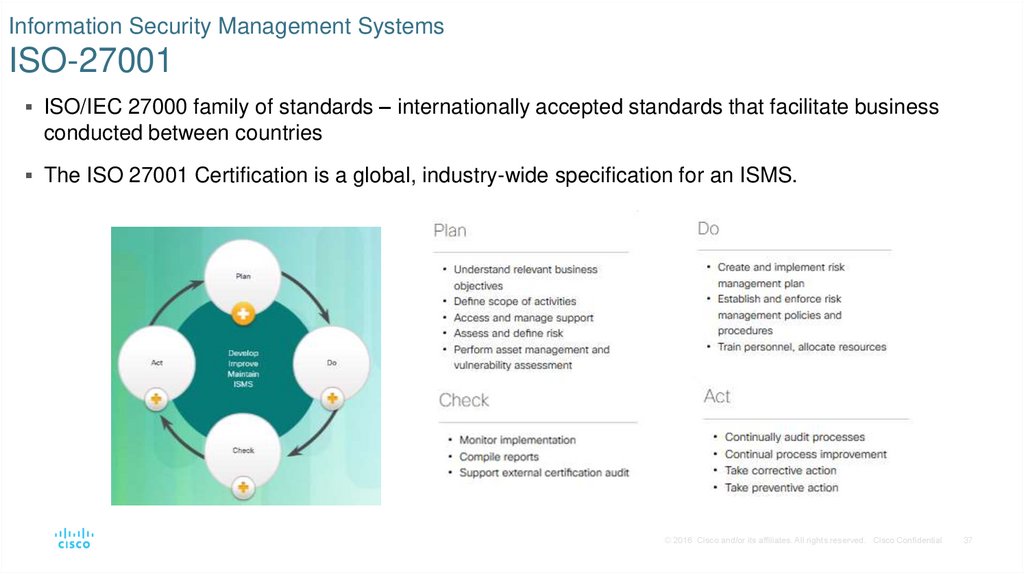
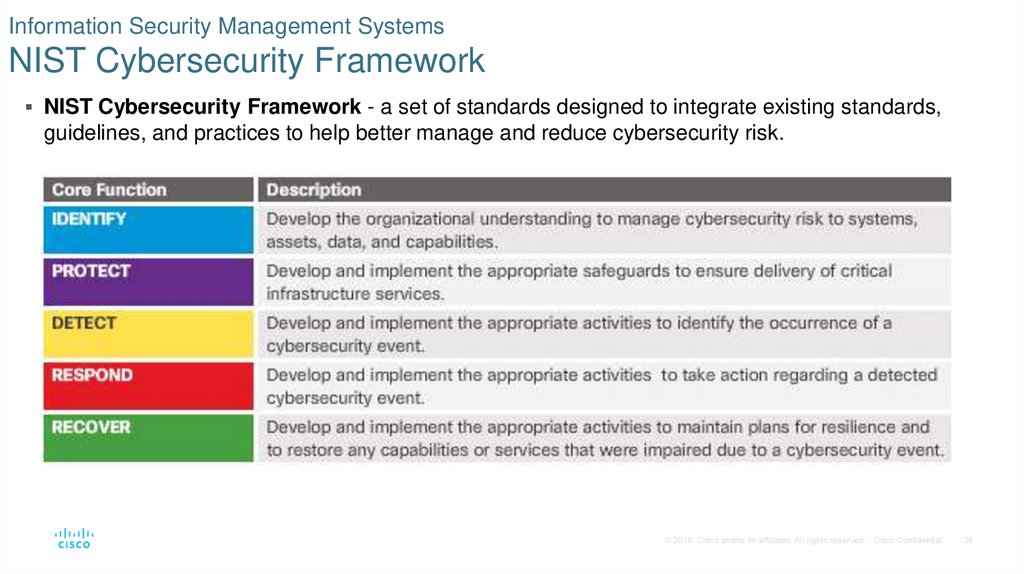

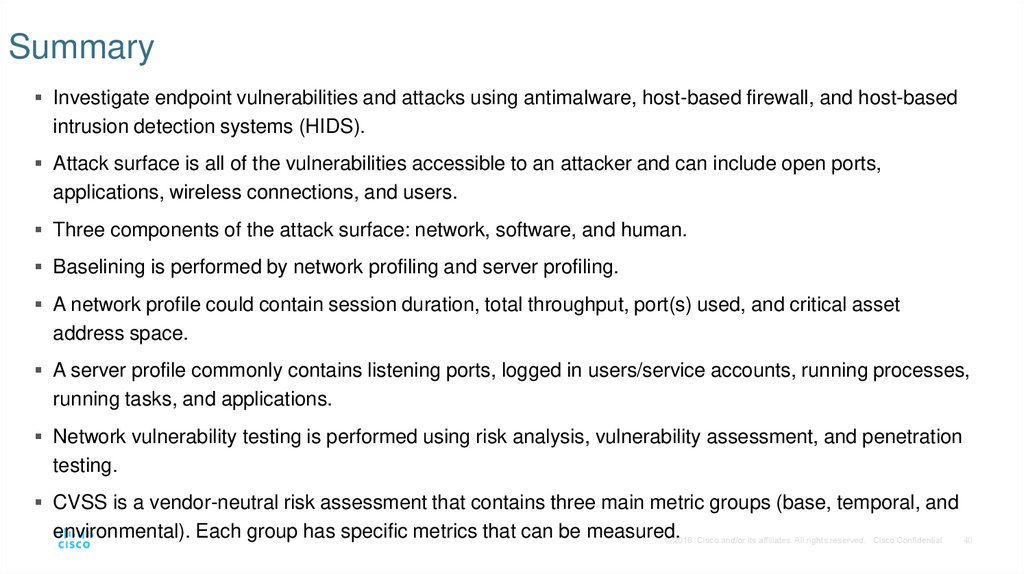
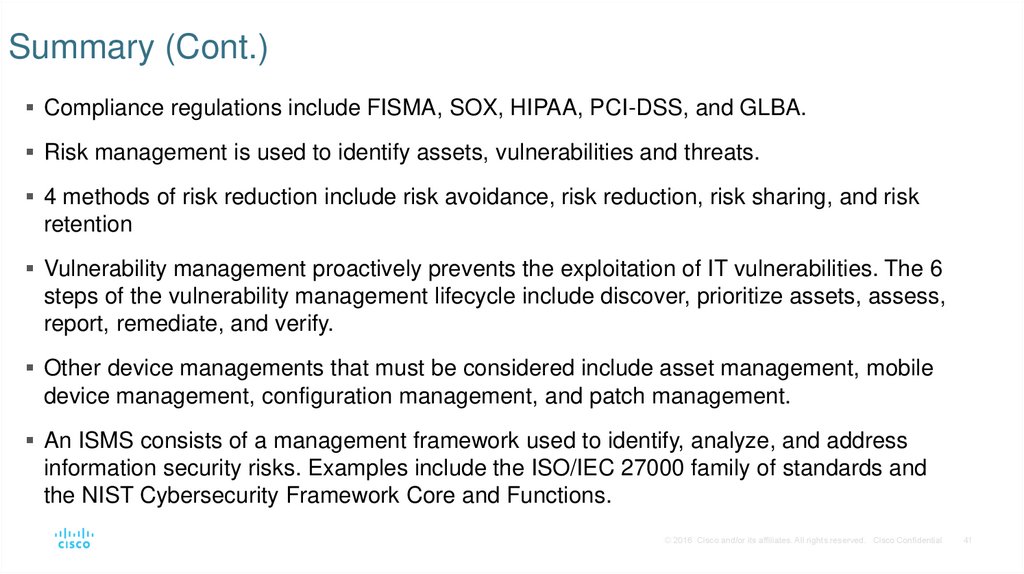
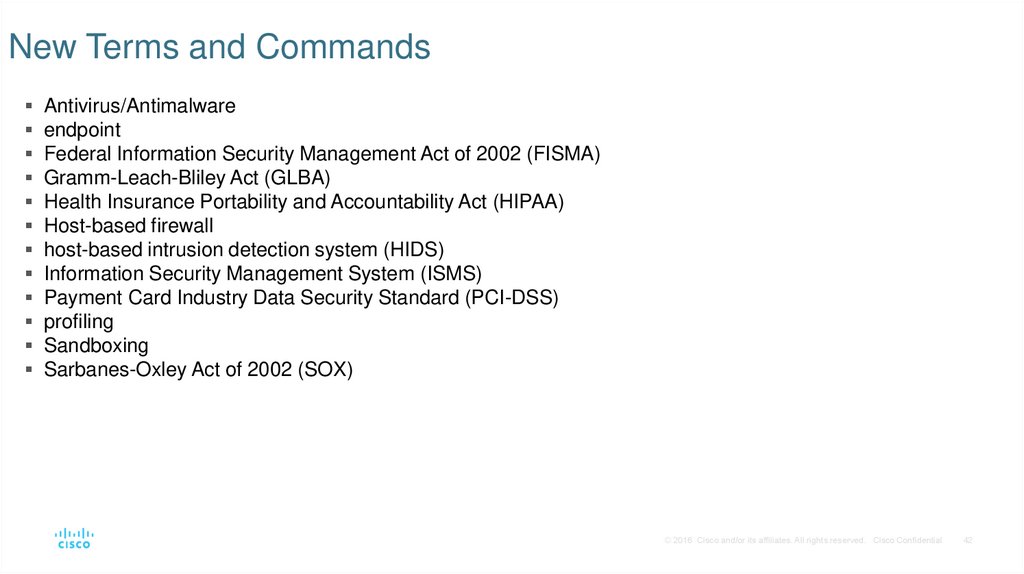
 internet
internet informatics
informatics








